Physical Touch: A Complete Guide to Understanding The Love Language
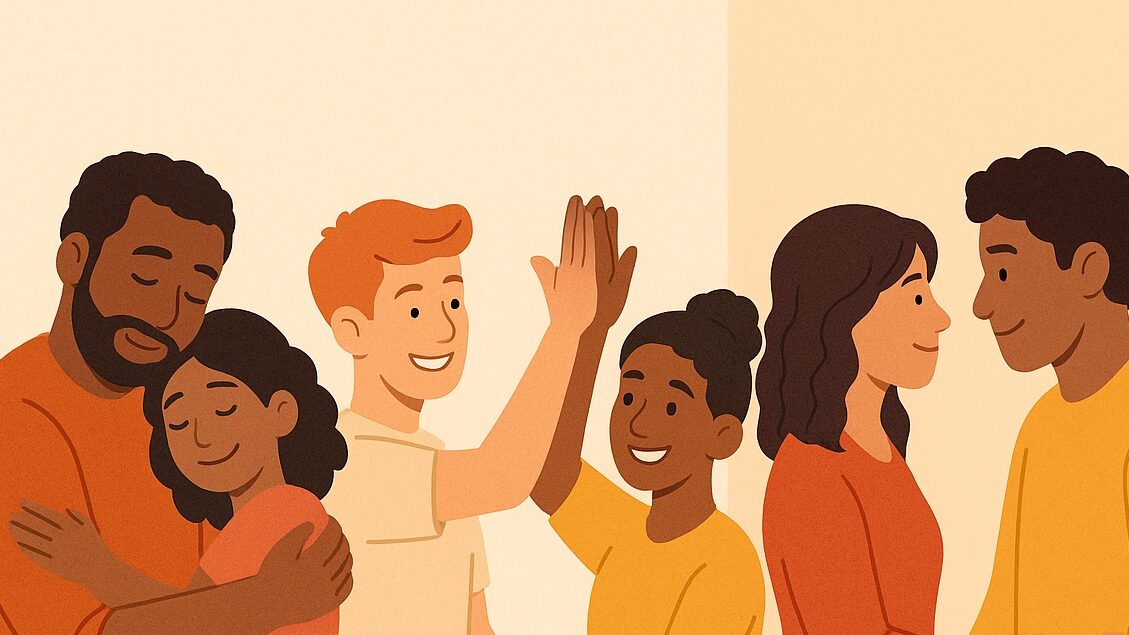
Physical Touch: A Complete Love Language Guide (2025)
If you’ve ever wondered whether Physical Touch is really your love language, struggled to understand the difference between affection and intimacy, or felt confused about appropriate boundaries, this comprehensive guide will help you navigate the complex but powerful world of loving through touch.
Understanding Physical Touch: Far More Than Intimacy
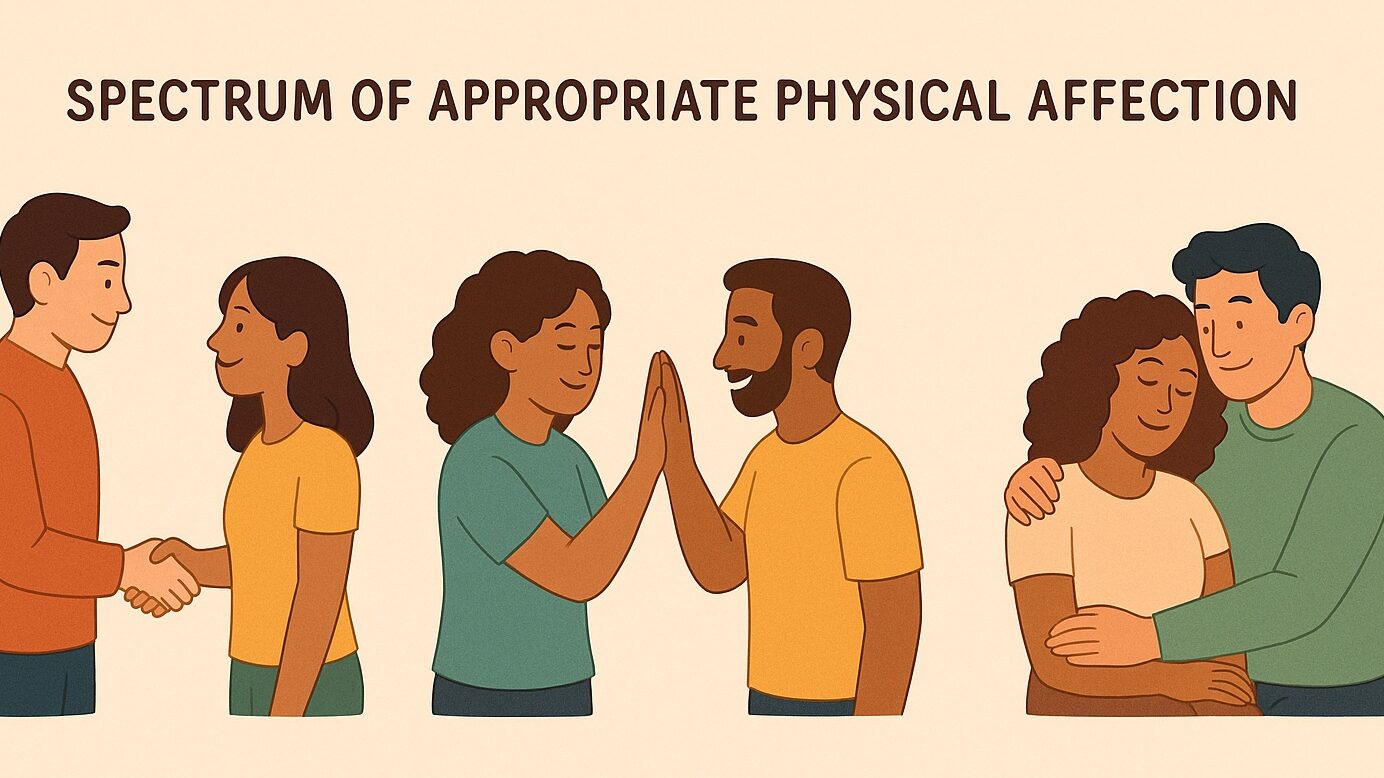
Physical Touch as a love language goes far beyond sexual contact. It includes all the ways we use appropriate physical connection to communicate care, comfort, support, and affection. For people with this primary love language, physical contact isn’t just pleasant—it’s essential for feeling emotionally secure and loved.
Research in attachment and relationship psychology shows that appropriate physical touch releases oxytocin, often called the “bonding hormone,” which creates feelings of safety, connection, and emotional well-being. For people whose love language is Physical Touch, these physiological responses are particularly strong and necessary for relationship satisfaction.
The Full Spectrum of Physical Touch:
Casual Affection:
- Hand-holding while walking or watching TV
- Brief touches on the arm, shoulder, or back during conversation
- High-fives, fist bumps, or playful physical gestures
- Sitting close together on the couch or at dinner
Comforting Touch:
- Hugs during greetings and goodbyes
- Supportive touch during difficult conversations
- Holding someone while they’re upset or crying
- Gentle back rubs when someone is stressed or tired
Playful Physical Connection:
- Dancing together in the kitchen or living room
- Gentle tickling or playful wrestling (with consent)
- Games that involve appropriate physical contact
- Spontaneous affectionate gestures like a quick shoulder squeeze
Intimate but Non-Sexual Touch:
- Cuddling while watching movies or reading
- Spooning or holding each other while falling asleep
- Massages focused on relaxation and care
- Running fingers through hair or gentle caressing
What Physical Touch is NOT:
- Exclusively sexual or leading to sexual expectations
- Possessive or controlling contact
- Touch that ignores consent or personal boundaries
- Physical contact that makes others uncomfortable
- Using touch as manipulation or to get something in return
The Science Behind Physical Touch and Emotional Connection
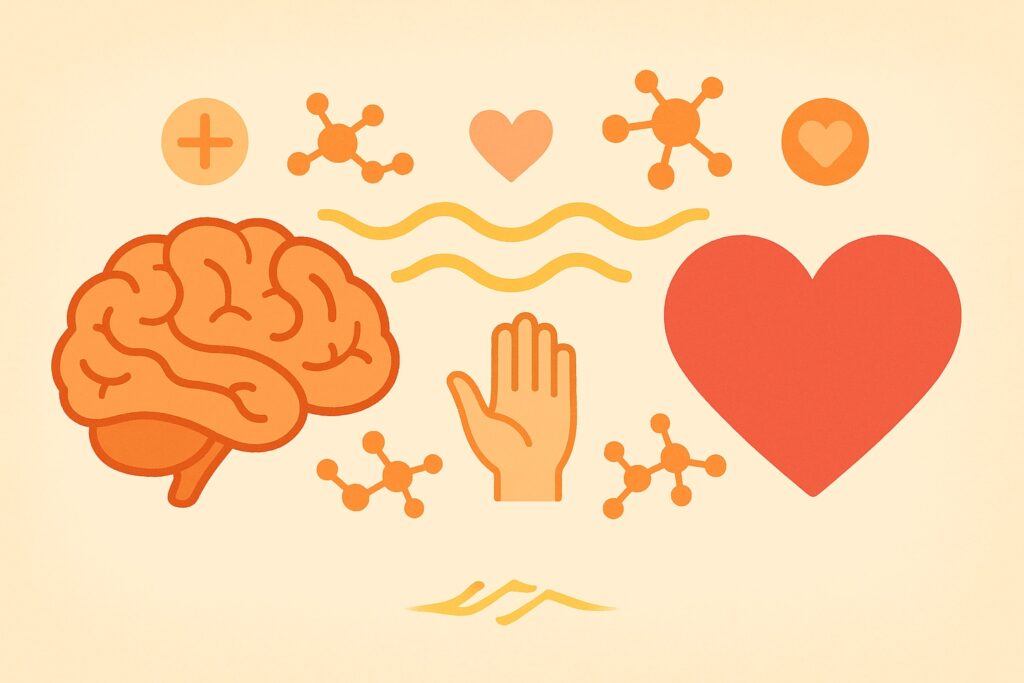
Understanding why Physical Touch creates such powerful emotional responses helps explain why it’s a fundamental love language for many people.
Neurological Benefits:
Physical touch activates the release of several important chemicals in the brain:
- Oxytocin: Creates bonding and trust
- Serotonin: Improves mood and emotional well-being
- Dopamine: Generates feelings of pleasure and reward
- Endorphins: Provide natural pain relief and comfort
Psychological Impact:
For people with Physical Touch as their love language, appropriate physical contact:
- Reduces stress and anxiety: Physical affection literally calms the nervous system
- Increases feelings of security: Regular appropriate touch creates emotional safety
- Enhances communication: Touch can convey emotions that words cannot express
- Builds intimacy: Non-sexual physical connection deepens emotional bonds
Developmental Importance:
Research shows that healthy physical affection throughout childhood and adulthood is crucial for emotional development and relationship satisfaction. People who experienced appropriate, loving touch growing up often have Physical Touch as a primary or secondary love language.
Common Misconceptions About Physical Touch
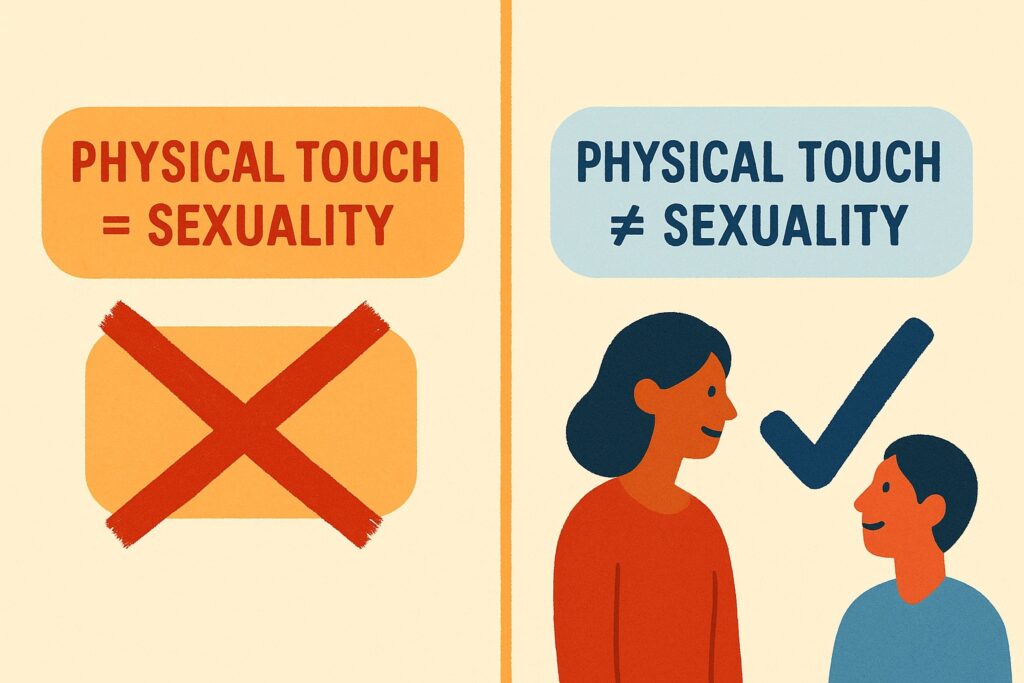
Physical Touch is perhaps the most misunderstood of all love languages, leading to confusion, boundary issues, and missed opportunities for connection.
Misconception 1: “Physical Touch is just about sex”
Reality: Sexual intimacy is only one small part of Physical Touch as a love language. The vast majority of physical touch expressions are non-sexual and appropriate for all types of relationships.
Impact of this misconception: People avoid giving or asking for physical affection, partners feel confused about expectations, and the full emotional benefits of appropriate touch are lost.
Misconception 2: “Men’s Physical Touch is always sexual”
Reality: Men, like women, can crave non-sexual physical affection for emotional connection and comfort. Cultural conditioning often limits men’s experience with appropriate physical affection outside of romantic/sexual contexts.
Impact of this misconception: Men may not receive the non-sexual physical affection they need, and their requests for physical connection may be misinterpreted as purely sexual.
Misconception 3: “Physical Touch isn’t appropriate in non-romantic relationships”
Reality: Appropriate physical affection is healthy and important in family relationships, friendships, and even some professional contexts (with proper boundaries).
Impact of this misconception: People miss opportunities to show care and support through appropriate touch in various relationships.
Misconception 4: “If someone needs Physical Touch, they’re ‘needy’ or clingy”
Reality: Needing physical affection for emotional well-being is a normal human trait, not a character flaw or sign of neediness.
Impact of this misconception: People feel ashamed of their need for physical affection and may not communicate this important emotional need to others.
Appropriate Physical Touch in Different Relationships
Understanding how Physical Touch appropriately appears in various relationship contexts helps avoid boundary confusion while meeting legitimate emotional needs.
In Romantic Relationships:
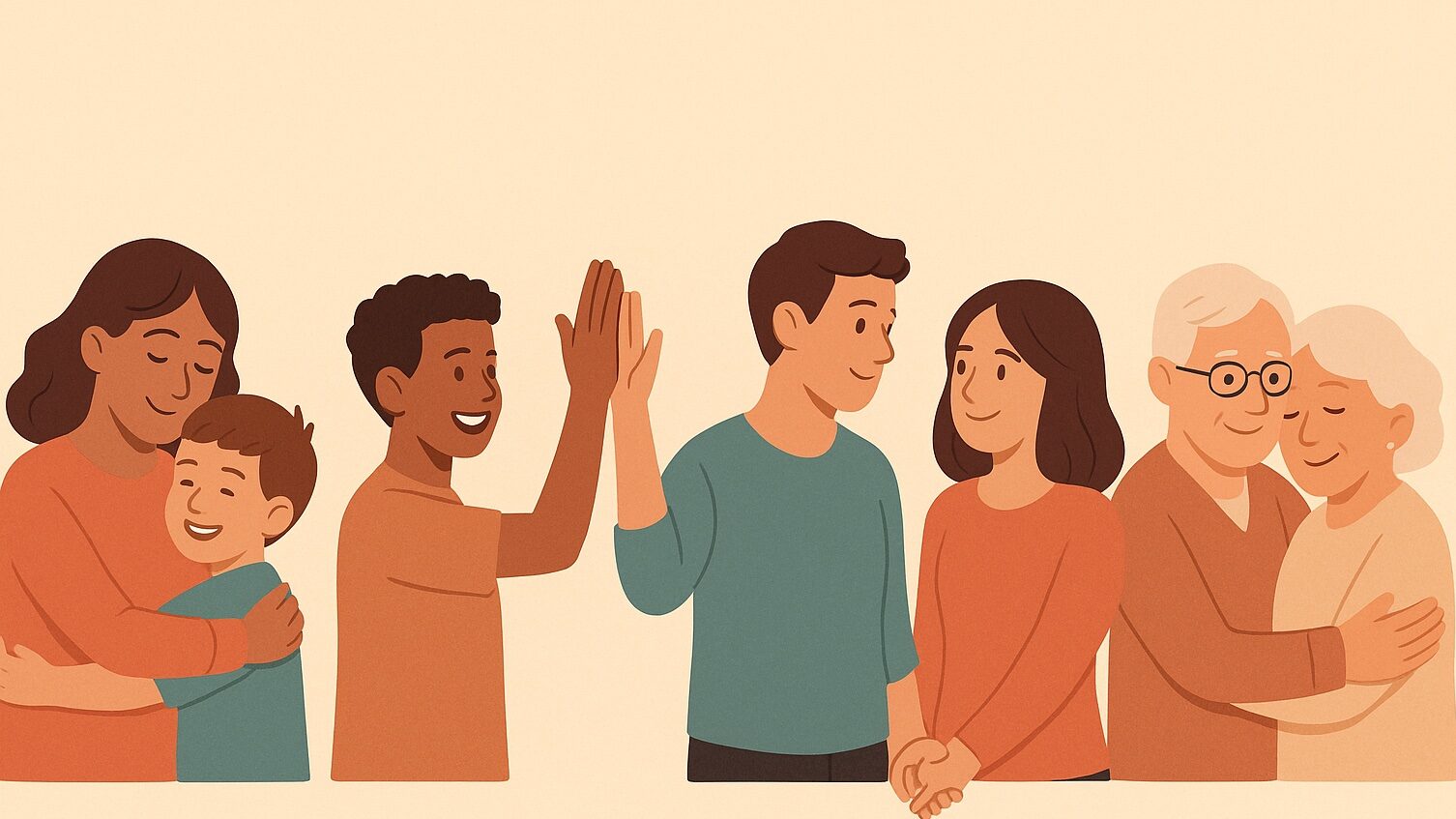
Daily Affection:
- Holding hands while walking, driving, or watching TV
- Quick kisses hello and goodbye
- Hugs that linger for a few extra seconds
- Casual touches while passing by—hand on shoulder, brief back rub
Comfort and Support:
- Extended hugs during stressful times
- Holding each other during difficult conversations
- Physical comfort when one partner is sick or upset
- Supportive touch during emotional moments
Playful Connection:
- Dancing together to music at home
- Playful tickling or gentle wrestling
- Giving each other massages for relaxation
- Cuddling during movies or while reading
Intimate Non-Sexual Touch:
- Spooning while falling asleep
- Running fingers through hair while talking
- Full-body hugs that create emotional connection
- Gentle caressing while having meaningful conversations
In Parent-Child Relationships:
Age-Appropriate Affection:
- Regular hugs and kisses appropriate to the child’s age and comfort level
- Holding hands with younger children
- High-fives, fist bumps, and celebratory physical gestures
- Comforting touch when children are hurt or upset
Developmental Considerations:
- Respecting children’s growing need for physical independence
- Maintaining appropriate physical affection even with teenagers (with their consent)
- Teaching children about consent and appropriate touch boundaries
- Modeling healthy physical affection in family relationships
In Friendships:
Culturally Appropriate Affection:
- Hugs during greetings and farewells (when welcomed)
- High-fives or fist bumps for celebrations
- Supportive touch on the arm or shoulder during conversations
- Comforting hugs during difficult times (with permission)
Boundary Awareness:
- Always respecting individual comfort levels with physical contact
- Understanding cultural differences in appropriate platonic touch
- Recognizing that some friends may not be comfortable with physical affection
- Communicating about physical boundaries when necessary
In Professional Settings:
Appropriate Professional Touch:
- Handshakes during introductions and business interactions
- Brief congratulatory touches (handshake, pat on back) for achievements
- Supportive touch during appropriate moments (hand on shoulder during difficult times)
- Cultural and context-sensitive physical greetings
Strict Boundaries:
- Understanding workplace policies about physical contact
- Respecting professional boundaries and power dynamics
- Never using touch in ways that could be misconstrued or make others uncomfortable
- Recognizing that professional settings generally require minimal physical contact
Recognizing Physical Touch as a Love Language in Others
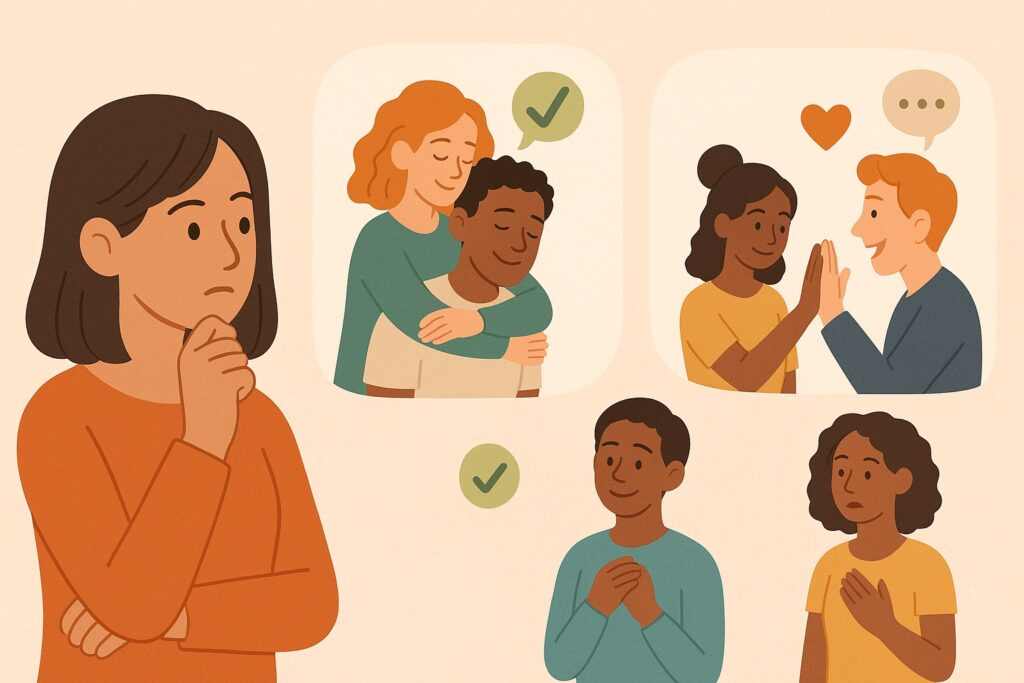
Learning to identify when someone has Physical Touch as their love language helps you connect with them more effectively while respecting appropriate boundaries.
Signs Someone Values Physical Touch:
They Initiate Appropriate Contact:
- They’re often the first to offer hugs or hold hands
- They sit close to others during conversations or activities
- They use appropriate touch to comfort others during difficult times
- They seem comfortable with and enjoy physical affection
They Respond Positively to Touch:
- They relax visibly when receiving appropriate physical affection
- They seem happier and more connected after physical contact
- They express appreciation for hugs, hand-holding, or other appropriate touch
- They reciprocate physical affection when it’s offered
They May Struggle Without Physical Contact:
- They seem distant or disconnected when physical affection is absent
- They may ask for hugs or other appropriate physical contact
- They appear more stressed or anxious when isolated from physical connection
- They may feel unloved despite receiving other expressions of care
What Physical Touch Looks Like in Practice:
In Conversations:
- Standing or sitting closer than others might
- Using appropriate touch to emphasize points or show support
- Naturally reaching out to touch someone’s arm during emotional moments
- Offering physical comfort automatically when others are upset
During Activities:
- Preferring activities that naturally include appropriate physical contact
- Enjoying dancing, sports, or games that involve physical interaction
- Seeking opportunities to be physically close during group activities
- Creating reasons for appropriate physical connection
How to Express Physical Touch Appropriately
If Physical Touch isn’t your natural love language but you want to connect with someone who values it, learning to give appropriate physical affection takes practice and sensitivity.
Starting Small and Building Comfort:
Begin with Safe, Brief Contact:
- Handshakes that last an extra moment
- Brief touches on the arm or shoulder during conversation
- High-fives or celebratory physical gestures
- Quick, appropriate hugs during greetings
Read Responses and Adjust:
- Notice how the person responds to physical contact
- Respect any signs of discomfort or withdrawal
- Ask permission for extended physical contact: “Would a hug help right now?”
- Build up to longer or more frequent appropriate touch gradually
Guidelines for Appropriate Physical Touch:
Always Consider Context:
- What’s appropriate varies by relationship type, setting, and cultural context
- Professional settings require stricter boundaries than personal relationships
- Public vs. private settings may call for different levels of physical affection
- Cultural backgrounds significantly influence comfort with physical touch
Respect Individual Boundaries:
- Some people aren’t comfortable with physical affection regardless of their love language
- Previous trauma may make physical touch difficult for some individuals
- Personal space preferences vary widely among individuals
- Always prioritize consent and comfort over expressing your affection
Focus on the Heart Behind the Touch:
- Physical touch should always come from genuine care and affection
- Never use touch to manipulate, control, or get something in return
- The goal is connection and comfort, not personal gratification
- Appropriate touch should make the recipient feel loved and secure
When Physical Touch Becomes Problematic
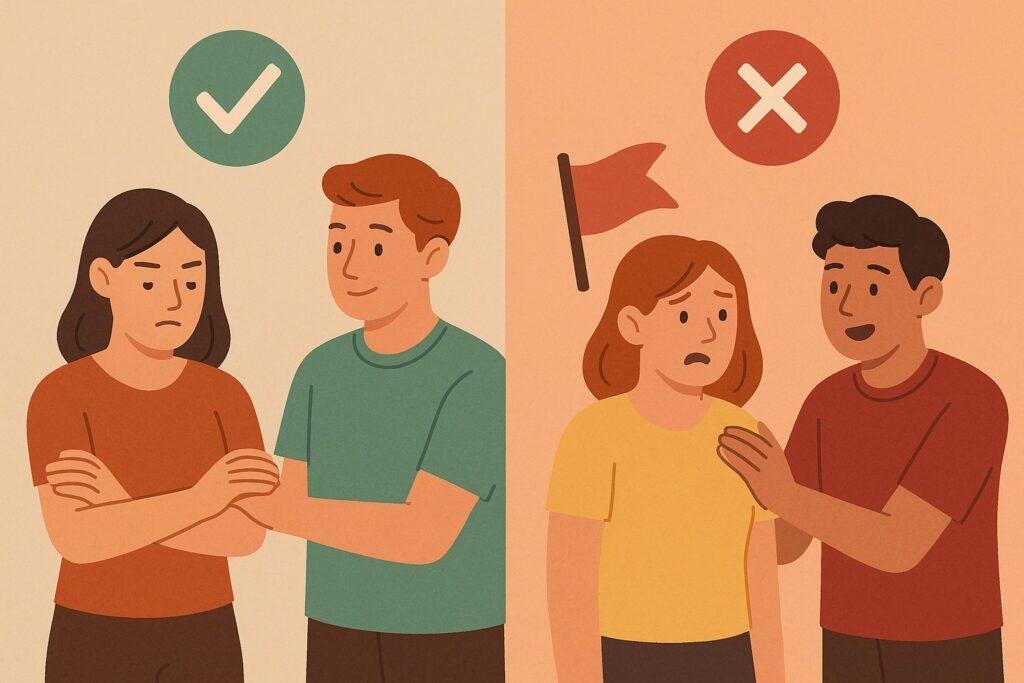
Like any love language, Physical Touch can be misused or become unhealthy when boundaries are ignored or when it’s used inappropriately.
Red Flags to Watch For:
Ignoring Consent or Boundaries:
- Continuing physical contact when someone pulls away or says no
- Using guilt or manipulation to pressure someone into physical affection
- Disregarding someone’s stated comfort level with physical touch
- Assuming that past consent means ongoing consent
Using Touch for Control:
- Physical contact that feels possessive or territorial
- Using physical affection as a reward/punishment system
- Touch that serves your needs rather than showing care for the other person
- Physical contact that makes others feel trapped or obligated
Inappropriate Context or Intensity:
- Physical touch that’s inappropriate for the relationship type or setting
- Escalating physical contact beyond what’s appropriate for the situation
- Using Physical Touch as your love language to justify inappropriate behavior
- Confusing your need for physical affection with sexual entitlement
Healthy Boundaries with Physical Touch:
Communicate Openly:
- Discuss comfort levels and boundaries with family members and close friends
- Ask permission for extended physical contact, especially with new relationships
- Be clear about your own needs while respecting others’ boundaries
- Have ongoing conversations about physical affection preferences
Respect Cultural and Individual Differences:
- Understand that comfort with physical touch varies greatly among individuals and cultures
- Don’t take someone’s discomfort with physical affection as personal rejection
- Learn about cultural norms around appropriate physical contact
- Adjust your expressions of Physical Touch based on feedback and responses
Physical Touch for Different Life Stages and Circumstances
The expression and reception of Physical Touch as a love language can vary significantly based on life stage, circumstances, and individual experiences.
Physical Touch in Different Life Stages:
Children and Adolescents:
- Young children often crave and benefit from appropriate physical affection
- Teenagers may need less frequent but still meaningful appropriate physical connection
- Teaching consent and appropriate boundaries becomes crucial during adolescence
- Family physical affection patterns often establish lifelong love language preferences
Adults:
- Physical Touch needs may change based on stress levels, life circumstances, and relationship status
- Singles may need to find appropriate ways to meet Physical Touch needs through family and friends
- Life transitions like parenthood may temporarily change Physical Touch preferences
- Health issues or physical limitations may require adapting how Physical Touch is expressed
Older Adults:
- Physical Touch may become even more important as other senses decline
- Health conditions may limit some types of physical affection while making others more crucial
- Loss of spouses or partners can create significant deficits in appropriate physical affection
- Grandparent relationships often provide important opportunities for Physical Touch expression
Special Circumstances:
Trauma and Physical Touch:
- Past trauma may make physical touch difficult or triggering for some individuals
- Healing often involves gradually rebuilding comfort with appropriate physical affection
- Professional support may be needed to navigate trauma-related touch issues
- Patience and understanding are crucial when trauma affects Physical Touch comfort
Neurodivergent Individuals:
- Sensory processing differences may make some types of touch overwhelming or uncomfortable
- Other individuals may crave more intense or frequent physical input
- Understanding individual sensory needs is crucial for appropriate Physical Touch expression
- Communication about sensory preferences helps ensure Physical Touch is comforting rather than overwhelming
Long-Distance Relationships:
- Physical separation creates unique challenges for people whose love language is Physical Touch
- Creative alternatives like synchronized activities or virtual presence may help
- Planning for meaningful physical connection during visits becomes especially important
- Other love language expressions may need to increase to compensate for lack of physical touch
Building Physical Touch Skills Gradually

If Physical Touch doesn’t come naturally to you but you want to connect better with someone who values it, developing these skills gradually will feel more authentic and comfortable.
Progressive Skill Development:
Week 1-2: Observation and Awareness
- Notice how comfortable you are with various types of appropriate physical contact
- Observe how others express and receive Physical Touch in different relationships
- Pay attention to your own physical boundaries and comfort levels
- Begin recognizing Physical Touch expressions in your daily life
Week 3-4: Basic Appropriate Touch
- Start with brief, clearly appropriate contact like handshakes or high-fives
- Practice giving hugs during appropriate greetings and farewells
- Try sitting closer to loved ones during conversations or activities
- Offer appropriate comforting touch when others are upset (with permission)
Week 5-8: Expanding Comfort Zone
- Increase frequency of appropriate physical affection with willing family and friends
- Practice longer hugs or hand-holding with romantic partners
- Learn to offer physical comfort during emotional conversations
- Experiment with playful appropriate physical contact
Week 9-12: Advanced Physical Touch Expression
- Develop skills in giving relaxing massages or back rubs
- Learn to use appropriate touch to enhance communication and connection
- Practice reading non-verbal cues about physical affection preferences
- Integrate Physical Touch naturally into various relationship contexts
Overcoming Common Barriers:
“I’m not a touchy person”: Start with minimal, clearly appropriate contact and gradually increase based on comfort and response. You don’t have to become someone you’re not, but small efforts can make a big difference.
“I don’t want to make others uncomfortable”: Learn to read non-verbal cues, ask permission when uncertain, and respect any signs of discomfort. Most people appreciate genuine, appropriate physical affection when it’s offered thoughtfully.
“It feels awkward or forced”: Like any new skill, appropriate physical affection feels unnatural at first. Focus on the caring intention behind the touch rather than perfect execution.
“I’m worried about boundaries”: Education about appropriate touch in different contexts, clear communication, and starting small can help navigate boundary concerns while still expressing care through Physical Touch.
Physical Touch Across Cultures
Cultural backgrounds significantly influence comfort levels, appropriateness, and expressions of Physical Touch, making cultural sensitivity crucial for appropriate expression.
Cultural Variations in Physical Touch:
High-Touch Cultures:
- Some cultures naturally incorporate more physical affection into daily interactions
- Greetings, farewells, and conversations may routinely include appropriate physical contact
- Physical Touch expressions may be more accepted and expected in these cultural contexts
- Understanding cultural norms helps navigate appropriate Physical Touch expression
Low-Touch Cultures:
- Other cultures maintain greater physical distance in most social interactions
- Physical affection may be reserved for very close family relationships or private settings
- Respecting cultural preferences for less physical contact shows cultural sensitivity
- Finding culturally appropriate ways to express care and connection becomes important
Gender and Cultural Expectations:
- Some cultures have different expectations for physical affection between different gender combinations
- Understanding these cultural nuances helps navigate appropriate Physical Touch expression
- Respecting cultural gender norms while still meeting legitimate Physical Touch needs requires sensitivity
Navigating Cultural Differences:
- Learn about the cultural backgrounds of people important to you
- Ask about physical affection preferences rather than assuming based on cultural stereotypes
- Respect cultural differences while communicating your own Physical Touch needs
- Find ways to bridge cultural differences that respect everyone’s comfort levels
The Long-Term Benefits of Appropriate Physical Touch
When expressed consistently and appropriately over time, Physical Touch creates profound positive impacts on relationships and individual well-being.
Relationship Benefits:
Enhanced Emotional Intimacy: Regular appropriate physical affection creates deeper emotional bonds and security in relationships of all types.
Improved Communication: Physical Touch can convey emotions and support that words alone cannot express, enhancing overall relationship communication.
Increased Relationship Satisfaction: People whose Physical Touch needs are met appropriately report higher satisfaction in their relationships and greater emotional well-being.
Stronger Conflict Resolution: Appropriate physical comfort during difficult conversations can help maintain connection even during disagreements.
Individual Benefits:
Better Physical Health: Regular appropriate physical affection has been linked to lower blood pressure, reduced stress hormones, and improved immune function.
Enhanced Mental Health: Appropriate Physical Touch reduces anxiety, depression, and feelings of loneliness while increasing overall emotional well-being.
Improved Self-Esteem: Receiving appropriate physical affection helps people feel valued, accepted, and worthy of love and care.
Greater Resilience: Having regular appropriate physical connection provides emotional support that helps people cope with life’s challenges more effectively.
Conclusion: The Healing Power of Appropriate Touch
Physical Touch as a love language encompasses far more than many people realize. It’s about the profound human need for appropriate physical connection that communicates safety, love, and belonging. When we understand and respect the boundaries around Physical Touch while recognizing its importance for emotional well-being, we unlock a powerful tool for deeper human connection.
For people whose primary love language is Physical Touch, appropriate physical affection isn’t a luxury—it’s a fundamental emotional need. When this need is met through respectful, consensual, and appropriate physical contact, it creates a foundation of emotional security that enhances every aspect of their relationships and well-being.
Whether you naturally express love through Physical Touch or are learning to connect with someone who does, remember that the goal is always genuine care expressed through appropriate physical connection. The investment you make in understanding and appropriately expressing Physical Touch will return to you in stronger relationships, deeper emotional bonds, and the satisfaction of meeting fundamental human needs for connection and belonging.
Understanding Physical Touch as part of the broader love languages framework helps create more complete and satisfying relationships for everyone involved. When we can fluently speak all the love languages, including appropriate Physical Touch, we become more effective at loving others in ways that truly matter to them.
Ready to Discover Your Love Language Profile?
Understanding whether Physical Touch is your primary love language—or learning how to appropriately express this love language to others—begins with taking our comprehensive assessment. Discover your unique love language profile and get personalized guidance for building stronger, more connected relationships through all five love languages.
Take the Love Language Quiz Now
Want to explore how Physical Touch intersects with other love languages? Learn about navigating different love language combinations in relationships, or discover how to communicate your Physical Touch needs appropriately and effectively.


Leave a Reply